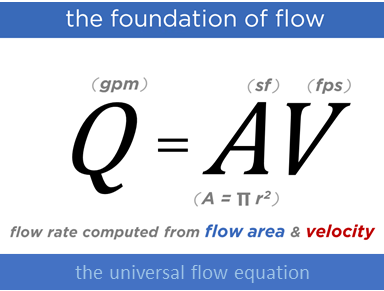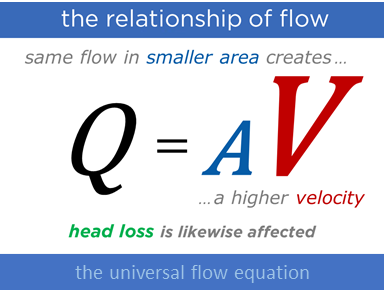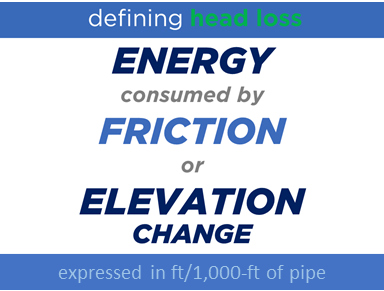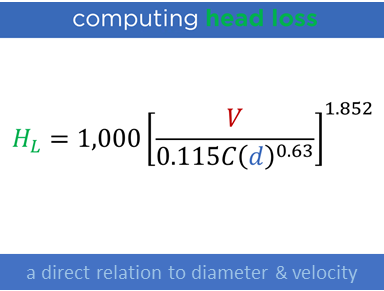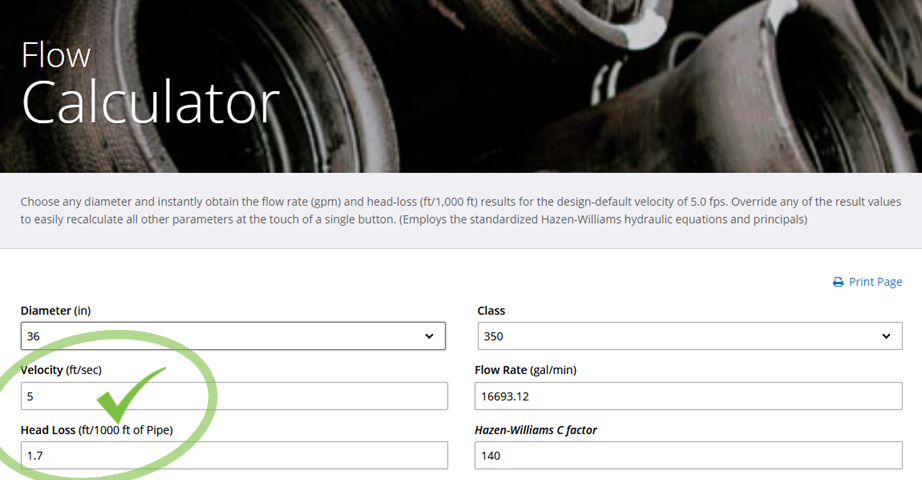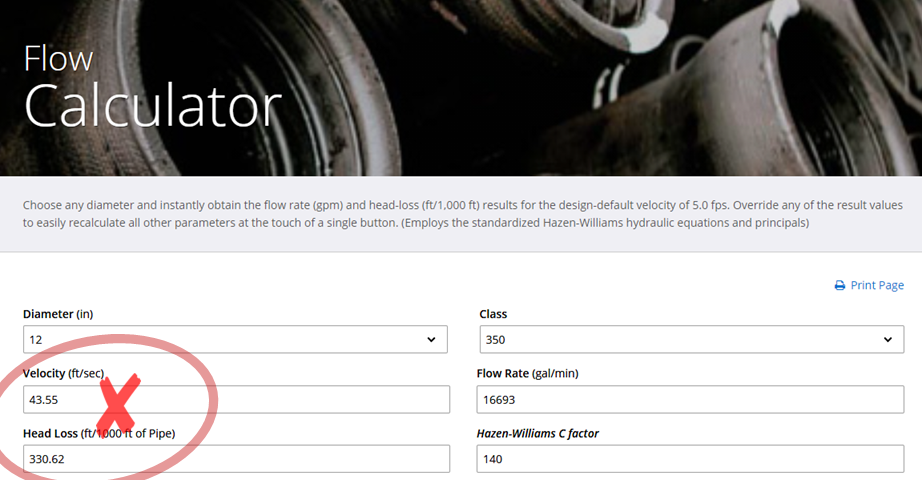How much water can I get through that pipe? What size pipe should I use to carry that much water? Two similar-sounding questions that, in truth, are entirely different. Not to mention, both are missing the keyword to consider in resolving each question, that word being "efficiently." The McWane Pocket Engineer (PE) Flow Calculator quickly and easily answers all three concerns - flow rate, pipe size, and flow efficiency.
Computation Basics
Everything within, about, and from this calculator is based upon the universal flow equation of Q=AV. This equation represents the flow rate (Q) as the product of the available flow area (A) and the velocity (V). If the available flow area changes, i.e., the pipe's inside diameter, the velocity must respond accordingly to maintain the flow rate. As velocity increases, so does the head loss, which is energy (psi) consumed by friction between the water and the pipe interior. The higher the head loss, the greater the energy consumed and/or needed to move water through the pipe, meaning less-efficient flow.
Targeted Ranges
Based on the ever-changing flow rate-gallons per minute (gpm) demands of an active pipeline or system, it is generally recommended that the velocity of the flow remain between 2.0 feet per second (fps) and 10 fps. Occasional short-term surges in velocities are common and, at least for Ductile iron pipe, not a concern worth talking about until a total velocity exceeds 20.0 fps.
The PE Flow Calculator employs a 5.0 fps default velocity to mirror most design engineers' average peak design value. Head loss (HL), expressed in units of ft/1,000-ft - which is functionally equivalent to psi (pounds per square inch) pressure consumed over that same length– does not necessarily have a recommended range. Yet, it is important to understand the entire concept of how HL plays into efficiency.
Pipeline Design: A Super-Simplified View
While a single toilet (1.6 gallons per flush), faucet (2.2 gpm), showerhead (2.5 gpm), or garden hose (8.0 gpm) does not require or provide a concerning amount of water themselves, if just half of a community of 50,000 people used some combination of these items for roughly no more than 15-minutes each day, this could equate to a daily need of at least 2.5-million gallons of water.*
Typical demands are most substantial in the mornings and evenings when people or families start or wrap up their days with common activities during those time slots, such as showering and/or cleaning the dishes. This timeframe is where peak flow rate demands exist, and therefore peak pipeline velocities occur as well. The pipe size, even different pipe sizes contained within a pipeline, do not change. Hence, HL drives the show.
Whether the energy to move water (psi) is provided from an elevated storage tank or pumps along the way, head loss subtracts psi in two ways – (1) friction losses as previously mentioned and (2) elevation differences along the pipeline.
For instance, if the system has 100-psi available to "push water" and there are 3-miles of pipe involved with a 30-foot elevation rise from the beginning of the pipeline to the highest point of delivery, the 30-foot elevation change at 0.433-psi per foot of elevation consumes 12-psi, while the 3-miles of friction (HL) – at let’s say an average of 4.2 psi per 1,000-ft of pipe, another 67-psi of the initial 100-psi available is spent, leaving 21-psi ** available pressure at points of delivery near the pipeline’s end. 20-psi is generally considered an acceptable level of pressure at a faucet or similar apparatus within a home or other building.
Booster pumps and other appurtenances typically respond throughout the day within a water delivery system to dance along with the varying demand. That’s where pipeline design, operation, and maintenance really get fun!
Play The Numbers
The PE Flow Calculator allows the user to change any input variables such as pipe size, flow rate, or velocity and quickly see the effect on the other variables, including computed head loss.
Wall class of the pipe and the Hazen-Williams flow coefficient (C), representing the pipe's interior surface smoothness, can also be adjusted from their default values by the user. Experiment freely with any combination of these inputs until you get the answer you need for an efficient pipeline design, especially if more than one pipe diameter will exist within your pipeline being considered
It all starts by going directly to pe.mcwane.com. Choose Ductile Iron Pipe / McWane Ductile / Calculators / Flow Calculator.
Exampling a 36-in pipe with the default values in place - wall class 350, the velocity of 5.0 fps, and a flow coefficient of 140 – we see that nearly 17,000 gallons per minute (gpm) is efficiently accommodated by this pipe with a head loss value of just 1.7-psi consumed per each 1,000-ft of pipe through which it flows.
Attempt to put that same flow rate (16,693 gpm) through a 12-inch pipe, and clearly, it is overwhelmed with velocity and head loss results far beyond acceptable norms. The PE Flow Calculator is all about balancing the rate of water used against the efficiency of the diameter chosen or involved.
An actual full-system detailed modeling of all the connected nodes in any pipeline network is required for a true analysis of a development, town, or city's water utility efficiency overall. Still, it all starts with choosing a reasonable-sized pipe, based on the golden rule of flow, Q=AV, as done here in the Pocket Engineer.
Coming Soon
This simple truth of flow being largely dependent on the internal diameter of the conduit will be expanded to explore the comparative annual pumping costs and present worth savings by using Ductile iron pipe versus other piping materials in an upcoming video exploring the McWane PE Energy Savings Calculator.
If you, as a designer with a project in hand, or just as a curious technical professional, would like to see one of the other calculators in the Pocket Engineer demonstrated before some others…drop us a note at marketing@mcwaneductile.com. We would love to hear from you! No strings attached. We want to serve your needs when they are needed!
Together, Building Iron Strong Utilities for Generations is the sole goal. Contact your local McWane Ductile Sales Representative or affiliated Utilities Distributor. They can assist or put you in touch with the appropriate Regional Engineer or Product Engineer to provide experienced hands-on consult in the field if needed.
Check Out All Our Digital Offerings
Footnotes to Calculation Examples
* 10-min. of faucet at 2.2-gpm + 15-min . of showerhead at 2.5-gpm + 5-min. of garden hose at 8.0-gpm = 100-gal/day/person x 25,000 people = 2,500,000 gallons used per day.
** (30-ft x 0.433 psi/ft) = 12-psi lost to elevation changes [(( 3-miles x 5,280 ft/mile) ÷ 1,000-ft) x 4.2] = 66.5-psi of frictional losses in flow. 100-psi - 12-psi - 67-psi = 21-psi at the furthest faucet.


